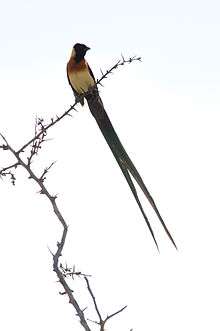Viduidae
| Viduidae | |
|---|---|
 | |
| Vidua interjecta | |
| Scientific classification | |
| Kingdom: | Animalia |
| Phylum: | Chordata |
| Class: | Aves |
| Order: | Passeriformes |
| Superfamily: | Passeroidea |
| Family: | Viduidae |
| Genera | |
The indigobirds and whydahs, are a family, Viduidae, of small passerine birds native to Africa.
These are finch-like species which usually have black or indigo predominating in their plumage. The birds named "whydahs"[1] have long or very long tails in the breeding male.
All are obligate brood parasites, which lay their eggs in the nests of estrildid finch species; most indigobirds use firefinches as hosts, whereas the paradise whydahs chose pytilias. Unlike the cuckoos and honeyguides, the indigobirds and whydahs do not destroy the host's eggs. Typically, they lay 2–4 eggs in with those already present. The eggs of both the host and the victim are white, although the indigobird's are slightly larger. Many of the indigo-plumaged species named "indigobirds" are very similar in appearance, with the males difficult to separate in the field, and the young and females near impossible. The best guide is often the estrildid finch with which they are associating, since each indigobird parasitises a different host species. For example, the village indigobird is usually found with red-billed firefinches. Indigobirds and whydahs imitate their host's song, which the males learn in the nest. Although females do not sing, they also learn to recognise the song, and choose males with the same song, thus perpetuating the link between each species of indigobird and firefinch. The nestling indigobirds mimic the unique gape pattern of the fledglings of the host species.
The matching with the host is the driving force behind speciation in this family, but the close genetic and morphological similarities among species suggest that they are of recent origin.
Species
- Genus Vidua
- Village indigobird, Vidua chalybeata
- Jambandu indigobird, Vidua raricola
- Barka indigobird, Vidua larvaticola
- Jos Plateau indigobird, Vidua maryae
- Quailfinch indigobird, Vidua nigeriae
- Dusky indigobird or variable indigobird, Vidua funerea
- Zambezi indigobird or green indigobird, Vidua codringtoni
- Purple indigobird or dusky indigobird, Vidua purpurascens
- Wilson's indigobird or pale-winged indigobird, Vidua wilsoni
- Cameroon indigobird, Vidua camerunensis
- Steel-blue whydah, Vidua hypocherina
- Straw-tailed whydah, Vidua fischeri
- Shaft-tailed whydah, Vidua regia
- Pin-tailed whydah, Vidua macroura
- Togo paradise whydah, Vidua togoensis
- Exclamatory paradise whydah or long-tailed paradise whydah, Vidua interjecta
- Long-tailed paradise whydah or eastern paradise whydah, Vidua paradisaea
- Sahel paradise whydah or northern paradise whydah, Vidua orientalis
- Broad-tailed paradise whydah, Vidua obtusa
- Genus Anomalospiza
- Cuckoo-finch or parasitic weaver, Anomalospiza imberbis
Notes
- ↑ The yellow-mantled widowbird was the type species of its genus, and was originally named from the city of Ouidah in Benin. Nowadays the name whydah (i.e. Ouidah) is however applied to the long-tailed species of the Viduidae.
References
- Payne, Robert (2010). "Family Viduidae (Whydahs and Indigobirds)". In del Hoyo, Josep; Elliott, Andrew; Christie, David. Handbook of the Birds of the World. Volume 15: Weavers to New World Warblers. Barcelona: Lynx Edicions. ISBN 978-84-96553-45-3. External link in
|title=(help)
External links
- Whydahs and indigobirds (Viduidae) information, including 7 species with videos and 9 with photographs at the Internet Bird Collection
- Indigobirds.com